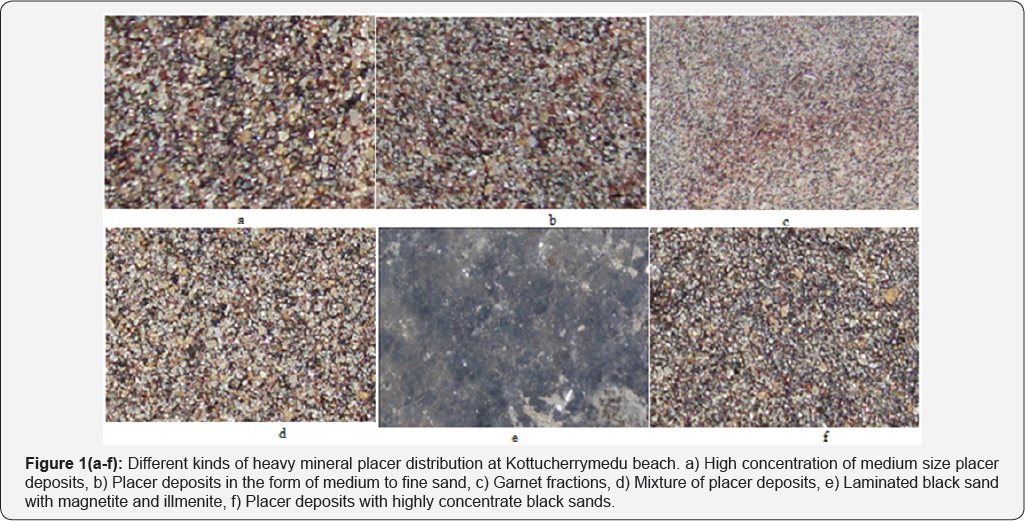Influence of Porosity in Quantitative Analysis of Heavy Mineral Placer Deposits- Juniper Publishers
Juniper Publishers- Journal of Oceanography
Abstract
The Heavy mineral analysis of the beach sediment is one of the finest ways to interpret the presence of the placer deposits in the coast. The point counting method is a widely used technique, which is employed for the quantitative analysis of heavy minerals. Nevertheless, this method is not applicable in case of large scale volumetric or spatial investigations as the surficial sediments occupy an inaccurate space due to its irregular grain size. Therefore, porosity is an important feature that has to be considered for the analyzing the quantitative distribution of the placer minerals present in the surface sediments. This paper highlights the effect of porosity in the heavy mineral distribution with respect to the grain size. The outcome from this research helps to enhance the results in quantitative analysis of heavy minerals.
Keywords: Heavy minerals, porosity, beach, sediments, grain size
Heavy mineral analysis

Quantitative investigation of mineral assemblages was relative mineral frequencies. This method provides information initiated by the work of Fleet and Smithson [1], who introduced of the relative percentage of each mineral present in the sample the method of grain counting to develop the estimation of [2]. In this particular research, field site is chosen along the Kottucherrymedu beach (Latitude: 10.964N and Longitude: 79.854E), central Tamil Nadu coast, India. The heavy mineral assemblage of the study region is controlled by the distribution of different type of minerals. Although the assemblage consists of various minerals, few selective placer minerals like magnetite, ilmenite, garnet, zircon and rutile [2-6] are the dominant minerals that are considered for this purpose. Totally 100 samples were collected at tide, berm and backshore region. The photographic view of different location, from which the sample is obtained, is shown in Figure 1. These samples were treated and categorized as medium (+40 to +60 ASTM), fine (+60 to +120 ASTM) and very fine (+120 to +230 ASTM) fractions. A high-density liquid i.e., Bromoform (specific gravity is 2.89 and molecular weight 252.73g/mol) is utilized for separation of heavy and light fractions. Further, the fraction of heavies is identified with the help of the microscope image counting method.
Porosity Estimation Using Petrographic Image Analysis (PIA)
Petrographic image analysis (PIA) is frequently used by geoscientists in a wide variety of petrographic applications including textural, mineralogical, fabric and porosity analysis [7-9]. A study of 150 thin sections of placer fractions with three different sizes (medium, fine and very fine) were prepared for the present investigation. Segmentation method is widely used to segregate the pores to improve the separation between pores and solid grains. This method can provide the total porosity; also it provides a highly accurate result in all the rocks except those that have an extremely isotropic/anisotropic pore structure. However, the advantage of this process is that, the pore types and the micro-textural properties of the grains can be determined during the process. A circular face with uniform magnification (400|im) was fixed in the imaging microscopy. The percentage of void space is evaluated from the microscopic images using pixel counting method.
Influence of Porosity in Heavy Mineral Quantity
The microscopic analysis shows respective fractions and its pore space for estimating total pore space present in the samples. Microscopic analysis of mineral distribution and its porosity value is presented in Table 1. Microscopic observation exposed that the porosity of garnet is much higher than that of other minerals. Garnet fractions is composed of angular/sub- angular structure hence, the particle reveals high porosity with less compaction nature. Rhombohedral crystalline structure of ilmenite has sub-angular and angular structure, obtains the porosity value with respect to crystalline structure and size of the particle distribution. The mixed fractions of the deposits are seen as Ilmenite-hematite, Ilmenite-leucoxene and magnetite- hematite minerals etc. It exhibits magnetic property when these fractions are mixed with other mineral fractions based on excessive electron/proton present in the crystalline structure. Zircon fractions show rounded and angular grains with medium pore space. The percentage of these mineral distribution is also compared with the results of normal counting method (Table 2). The results obtained based on the porosity value, revealed lesser percentage when compared to the normal counting method. The medium sized garnet showed a higher porosity value while ilmenite showed a lower porosity value. It is observed that, the porosity value decreases when the sediment size decreases. On the whole, the outcome revealed the porosity value of the more- angular grains is larger than those that are sub-spherical.


Comments
Post a Comment